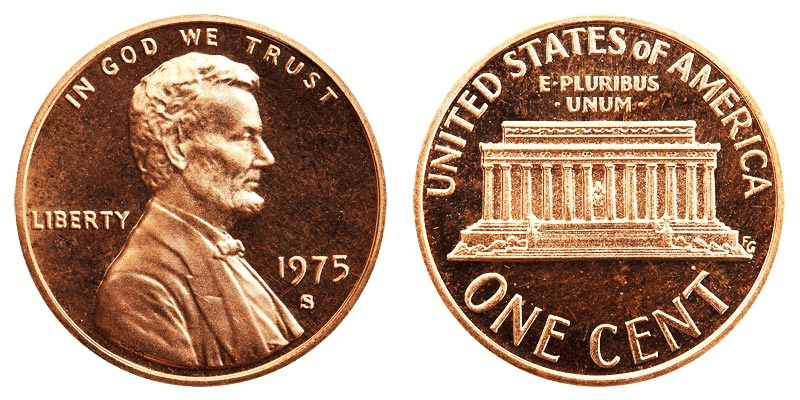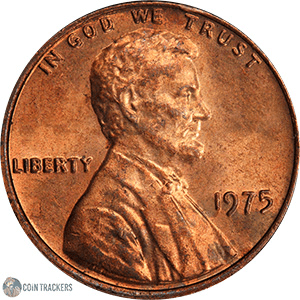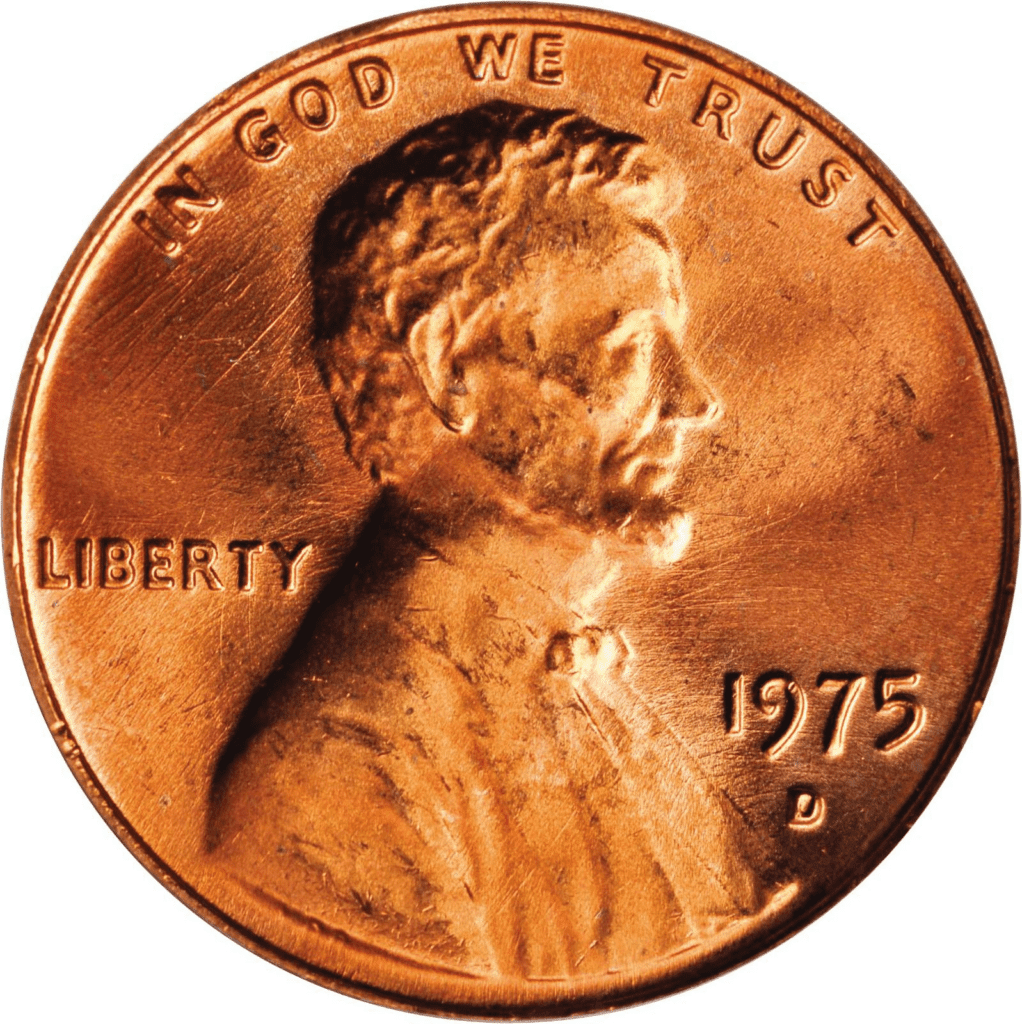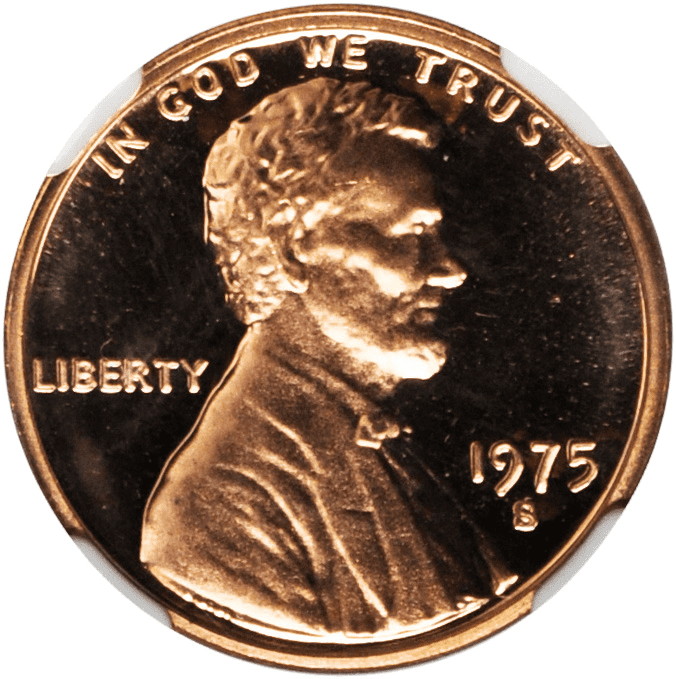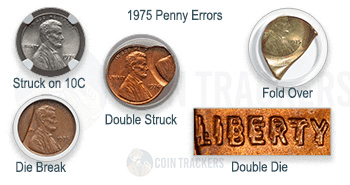What Is A 1975 Penny Made Of?

photo source: USA Coin Book
The 1975 penny is made of 95% copper and 5% zinc. It was minted in 1975 with a face value of $0.01. It has a total weight of 3.11 grams.
The 1975 one-cent coin is often called the “penny.” It features the right-facing bust of Abraham Lincoln on the obverse. The top part of the coin reads, “IN GOD WE TRUST.”
On the right side is the 1975 inscription and on the left side is the word, “LIBERTY.” If present, you’ll find the mint mark below the year.
On the reverse, you’ll find the image of the Lincoln Memorial, front view. You then see the various inscriptions that include the following:
- UNITED STATES oF AMERICA (top)
- ONE CENT (bottom)
- E PLURIBUS UNUM (on top of the Lincoln Memorial)
The first US penny was first produced in 1787. It has gone through different design changes. Some of the designs it featured in the past include the flowing hair chain, liberty cap, draped bust, and flying eagle.
The Lincoln design was used in 1909, which coincided with the president’s 100th birthday. This has replaced the Indian head cent. However, the Lincoln Memorial on the reverse was later adopted in 1959 to replace the wheat-stalks image.
Did you know that the penny is the most produced coin in the United States?
Not only that, but the Lincoln penny was the first time that the US used a portrait as part of a design. Prior to 1909, it was always the mythical Liberty that was featured on the coin. This led to other coins being changed to bear portraits of other people.
1975 Penny Varieties
The 1975 Lincoln penny comes in various designs. However, the main differential character would be their mint mark. There are also some pennies that have errors, giving rise to other varieties.
To give you an idea, here are some of the most well-known 1975 pennies.
1975 Penny With No Mint Mark
Year: 1975
Mint Mark: None
Quantity produced: 5,451,476,142
Face Value: $0.01
Price: $0.01 to $9.00 (or more)

photo source: Coin Tracker
The Lincoln penny with no mark was struck in Philadelphia. There were over five billion of these pennies that were struck. With a face value of $0.01, you might be able to sell one of these for as much as $9, depending on your coin’s status.
1975 D Penny
Year: 1975
Mint Mark: D
Quantity produced: 4,505, 275,300
Face Value: $0.01
Price: $0.01 to $30.00 (or more)

photo source: Coin Appraiser
The 1975 D penny is seen to be more valuable than the other standard varieties. Collectors would value those coins with mint state certifications.
The mint mark is “D”, which indicates it was made in Denver. More than 4.5 billion of these coins were struck.
1975 S Penny
Year: 1975
Mint Mark: S
Quantity produced: 2,845,000
Face Value: $0.01
Price: $0.01 to $5.00 (or more)

photo source: Coin Appraiser
One 1975 S penny is usually sold for its face value, which is 1 cent. However, certified mint state S pennies can be sold for $5.00.
The S mint mark represents San Francisco and almost 3 million of the S variety were struck.
1975 list of errors
There were a few known errors that happened during the minting of the Lincoln penny. With billions of pennies produced, it is expected that some were not minted properly.
Here are some of the known errors you should know:

photo source: Coin Trackers
- 1975 silver penny – the error happened when a blank dime was included in the minting process for the penny. As a result, there were a few pennies that looked like they were made of silver. However, please note that the US Mint stopped producing silver coins by 1965. So, what seems to be silver is actually just made of aluminum.
- Doubled die – doubled die 1975 pennies happened when a planchet was struck twice. Normally, once a penny is struck, the machine automatically ejects it from its place. However, sometimes the machine fails and so, the penny gets stuck and inevitably receives two blows.
- 1975 DDO/DDR – there are plenty of double-struck 1975 D and P pennies because the error wasn’t discovered immediately. The double strikes are most noticeable on the letters.
- Die break error – because of repeated strikes, a certain portion of the die breaks or cracks. That’s why you’ll find a crack mark on some 1975 pennies. One good example of this is the 1C Lincoln cents.
- Fold over – sometimes, planchets were not properly leveled. Because of this, the planchet folded over on top of itself.
Are There Any Rare 1975 Pennies?
The US Mint produced almost 10 billion of 1975 pennies. Thus, the 1975 Lincoln pennies are not that rare. Here’s a quick look at the quantities:
| Series | Location | Quantity produced |
| 1975 S | San Francisco | 2,845,450 |
| 1975 D | Denver | 4,505,275,300 |
| 1975 | Philadelphia | 5,451,476,142 |
As this might be the case, there are still rare 1975 pennies and they exist primarily because of minting errors.
The rare 1975 pennies include 1975 DDO/DDR, 1975 Silver Penny, 1C Lincoln Cents, Doubled Die, and fold-over.
The minting centers made pennies predominantly with copper. There’s one “silver” penny, but actually just aluminum. No gold pennies are known to have been produced. The red pennies are a result of discoloration.
How Much Is A 1975 Penny Worth Today?
The ordinary 1975 penny is valued the same as its face and melt value which is $0.01. The uncirculated, proof pennies are more valuable than the circulated pennies. You can earn up to $30 for the uncirculated ones.
The 1975 S-proof penny with a PR 65 condition is worth around $3.50. The 1975 D penny can be around $1 if it is MS 65 grade and hasn’t been part of the circulation.
However, if you have the rare 1975 pennies, then you can earn a lot from them.
Just to give you an example, you can sell the silver 1975 pennies for $200 to $600. For errors with repunched mintmarks, you may earn $3-$10. The 1975 Pennies With Die Breaks can be $3-$150 depending on the condition. People with the 1975 Doubled Die Pennies can sell their coins for $25 to $100.
How Does The Grading System Work?
The Sheldon Scale is used by numismatists to provide a numerical value to coins. The Sheldon Scale goes from poor (P-1) to perfect mint state (P-1) (MS-70). Coins were originally evaluated using words to reflect their condition (Good, Fair, Excellent, Etc.). Unfortunately, coin collectors and dealers had different ideas about what each of these terms represent.
Professional numismatists joined together in the 1970s and established CoinGrading standards. These numismatists now assign grades at key places on the seventy-point scale, using the most regularly utilized numeric points in conjunction with the original adjective grade. The following are the most common coin grades:
-
-
- (P-1) Poor – Indistinguishable and probably damaged; if used, must have a date and mintmark; otherwise, rather battered.
- (FR-2) Fair – Nearly smooth, but without the damage that a coin graded Poor often possesses. The coin must have enough detail to be identified.
- (G-4) Fair – Inscriptions have merged into the rims in some areas, and important elements have been mostly erased.
- (VG-8) Very Good- A little weathered, but all of the primary design elements are visible, albeit faintly. There is little if any, central detail left.
- (F-12) Good – The item is very worn, yet the wear is even, and the overall design details stand out clearly. Rims are almost completely isolated from the field.
- (VF-20) Very Fine – Moderately weathered, with some finer features still visible. The motto or all letters of LIBERTY are readable. Both sides of the coin have entire rims that are separated from the field.
- (EF-40) Extremely Fine – Gently used; all gadgets are visible, and the most important ones are bold. The finer details are bold and clear, however, light wear may be seen.
- (AU-50) Uncirculated – Slight evidence of wear on the coin’s design’s high points; may have contact marks; eye appeal should be adequate.
- (AU-58) Uncirculated Choice – Slight traces of wear, no severe contact marks, almost full mint shine, and great eye appeal.
- (MS-60) Mint State Basal – Strictly uncirculated; no indication of wear on the coin’s highest points, but an unsightly coin with reduced luster, visible contact marks, hairlines, and other flaws.
- (MS-63) Mint State Acceptable – Uncirculated, but with contact scratches and nicks, little reduced shine, but otherwise appealing appearance. The strike is weak to average.
- (MS-65) Mint State Choice – Uncirculated with great mint shine, very little contact blemishes, and exceptional eye appeal. The strike is unusually severe.
- (MS-68) Mint State Premium Quality – Uncirculated with superb luster, no obvious contact marks to the naked eye, and exceptional eye appeal. The strike is quick and appealing.
- (MS-69) Almost Perfect Mint State – Uncirculated with perfect brilliance, a sharp and appealing strike, and extremely good eye appeal. A near-perfect coin with minor imperfections in the planchet, strike, and contact markings (seen only under 8x magnification).
- (MS-70) Mint State Perfect – Under 8x magnification, there are no tiny imperfections discernible; the strike is crisp, and the coin is perfectly centered on a beautiful planchet. Rarely seen on a coin, this coin is bright and whole, with original luster and exceptional eye appeal.
-
Where To Buy Or Sell 1975 Pennies?
With the Internet, selling and buying 1975 pennies are made easier. Of course, be sure to do a background check. Whether you are selling or buying precious pennies, you can’t take away the fact that there are plenty of scams online. So, be very careful.
Aside from online platforms, you can also try coin shops, collectors’ hubs, antique shops, and other brick-and-mortar stores.
FAQs
What is the value of a 1975 Canadian penny?
The 175 Canadian penny is about $0.04 CAD. it can go up depending on the quality, rarity, supply, demand, finish, and other factors.
Which 1975 penny is worth the money?
The 1975 pennies with higher prices are the ones that didn’t enter circulation. The pennies with errors have the highest value because of their rarity. Proof pennies are also valued more than standard coins.
How much is a 1975 bicentennial penny?
The 1975 bicentennial penny is worth around $2 to $4. The price can increase depending on the penny’s condition and rarity.

